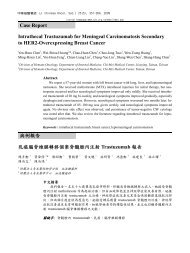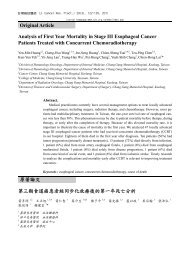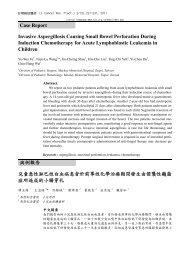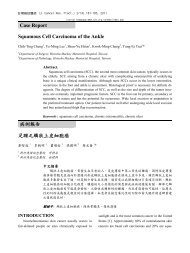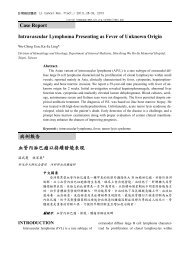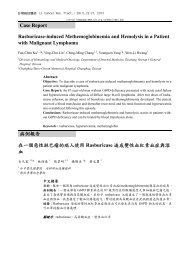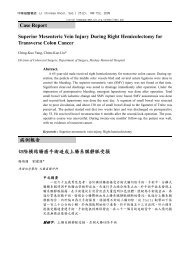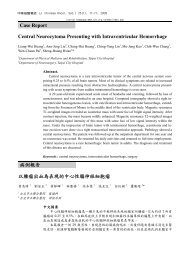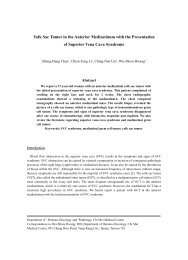Case Report Invasive Mucinous Adenocarcinoma of the Lung ç ä¾ ...
Case Report Invasive Mucinous Adenocarcinoma of the Lung ç ä¾ ...
Case Report Invasive Mucinous Adenocarcinoma of the Lung ç ä¾ ...
Create successful ePaper yourself
Turn your PDF publications into a flip-book with our unique Google optimized e-Paper software.
H. T. Liu et al./JCRP 28(2012) 94-98 95<br />
tinued [1]. Unlike adenocarcinoma in situ (AIS) and<br />
minimally invasive adenocarcinoma (MIA), which<br />
both have nearly 100% 5-year survival rates, invasive<br />
mucinous adenocarcinoma (formerly mucinous BAC)<br />
has a comparatively poorer prognosis. Within <strong>the</strong> criteria<br />
for <strong>the</strong> new staging system, <strong>the</strong>re is no collected<br />
survival data that has been fully presented for mucinous<br />
adenocarcinoma <strong>of</strong> <strong>the</strong> lung. However, prior literature<br />
shows that <strong>the</strong> disease has unusual clinical<br />
presentation and distinct immunohistochemical features.<br />
CASE REPORT<br />
A 50-year-old woman was transferred to our hospital.<br />
One month before admission, she had increasing<br />
shortness <strong>of</strong> breath and progressive facial swelling.<br />
She visited a local hospital for medical assistance,<br />
where a subsequent chest X-ray showed massive right<br />
pleural effusion and widening <strong>of</strong> <strong>the</strong> upper mediastinum.<br />
Thoracentesis yielded bloody exudative effusion,<br />
and a pig-tail tube was inserted for drainage. The<br />
drainage volume was 400-500 ml per day. Subsequently,<br />
<strong>the</strong> pig-tail tube was <strong>the</strong>n replaced by a chest<br />
tube due to blood clot occlusion. Cytological examination<br />
indicated adenocarcinoma. The patient’s chest<br />
CT scan depicted massive right pleural effusion, a<br />
thrombus at <strong>the</strong> superior vena cava, and a 3 x 3 cm<br />
mass at <strong>the</strong> anterior mediastinum. The thrombus was<br />
thought to be tumor-related. CT-guided biopsy <strong>of</strong> <strong>the</strong><br />
anterior mediastinum mass revealed metastatic adenocarcinoma<br />
with immunohistochemical stain as CK7<br />
(-), TTF-1 (-), CK20 (+) and CDX2 (+), suggesting<br />
metastatic adenocarcinoma <strong>of</strong> <strong>the</strong> lower gastrointestinal<br />
tract. The patient underwent esophagogastroduo-<br />
*Corresponding author: Yuh-Min Chen, M.D., Ph.D.<br />
* 通 訊 作 者 : 陳 育 民 醫 師<br />
Tel: +886-2-28757563<br />
Fax: +886-2-28763466<br />
E-mail: ymchen@vghtpe.gov.tw<br />
Figure 1. <strong>Mucinous</strong> pools contain poorly differentiated<br />
adenocarcinoma cells (200X)<br />
denoscopy (EGD endoscopy) and colonoscopy, with<br />
resulting negative findings. PET/CT scan revealed uptake<br />
in <strong>the</strong> patient’s anterior mediastinum and <strong>the</strong> right<br />
lower lung, and she was <strong>the</strong>n treated as metastatic adenocarcinoma<br />
<strong>of</strong> lower gastrointestinal origin. After this<br />
diagnosis, <strong>the</strong> patient came to our hospital for a second<br />
opinion, where additional diagnostic tests were performed.<br />
Similar to her previous results, <strong>the</strong> patient’s<br />
brain MRI and mammography were negative; gynecological<br />
ultrasound exam revealed myomas only. We<br />
repeated <strong>the</strong> chest CT scan and performed biopsy to <strong>the</strong><br />
pleural lesions. The pathology report showed metastatic<br />
adenocarcinoma with immunohistochemistry noted as<br />
CK7 (+), CK20 (+), CDX2 (+), TTF-1 (-), CK5/6 (-),<br />
and P63 (-) (Figures 1, 2). EGFR sequencing reported<br />
no mutation. Because <strong>of</strong> <strong>the</strong> discordance <strong>of</strong> immunochemistry<br />
pr<strong>of</strong>iles between <strong>the</strong> pleural sample and <strong>the</strong><br />
anterior mediastinal tumor, we discussed this case in<br />
our lung cancer multidisciplinary conference. The<br />
members concluded that <strong>the</strong> tumor was compatible with<br />
invasive mucinous adenocarcinoma <strong>of</strong> lung, and we<br />
treated <strong>the</strong> patient with paclitaxel plus cisplatin. Three<br />
days later, her pleural effusion markedly decreased, and<br />
chest film indicated widening <strong>of</strong> <strong>the</strong> anterior mediastinum.<br />
We maintained this regimen for 2 months, but<br />
unfortunately her disease progressed (Figure 3).




